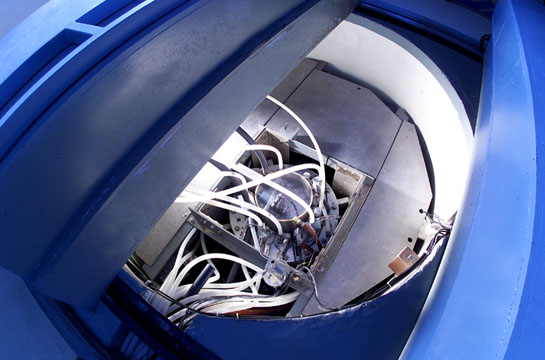Update: SRC's SLOWPOKE-2 nuclear research reactor has been safely and successfully decommissioned after 38 years of successful operation.

This is a contributed blog post written by former SRC employee Dave Chorney.
Six metres below the floor of SRC Environmental Analytical Laboratories, you'll find a Safe Low-Power Kritical Experiment, or SLOWPOKE-2, nuclear research reactor set into the concrete floor of our lab.
SRC is home to one of five SLOWPOKE-2 low-power research reactors in the world. What started out as a hole in the ground thirty-four years ago at SRC Environmental Analytical Laboratories is now a thriving, successful and valuable nuclear reactor with over 18,641 hours of commercial and research operation, 180 megawatt hours of thermal energy released and around 250,000 tests completed. While the ultimate authority for SLOWPOKE-2 lies with SRC’s CEO, day-to-day operations are overseen by a Facility Administrator. As the current Administrator, I’ve been involved with, and certified by the Canadian Nuclear Safety Commission (CNSC) to operate, the reactor for 28 years.
People often ask, “What’s the difference between a SLOWPOKE-2 research reactor and a typical CANDU power reactor?” Here’s one way to think about it: in terms of size and power, the SLOWPOKE-2 could be compared to a scooter – small, safe and ideally suited for its purpose. The CANDU is more like a Ferrari – large, complex and powerful. The SLOWPOKE-2 produces a maximum 20 kilowatts of power, as opposed to as much as 800 megawatts of power produced by a CANDU reactor.
As the name suggests, the SLOWPOKE-2 is extremely low-power and while it has a variety of functions, it is used primarily as an analytical tool for commercial analysis and for research. The SLOWPOKE-2 uses neutrons to analyze and determine uranium concentrations. Users of our reactor come from a variety of places and industries, such as mining, oil and gas, and environmental and health sciences. For instance, when mining companies explore for potential mine sites they use our reactor to analyze samples for uranium concentrations. The reactor also helps with environmental remediation work by testing oils, sludge and water samples for organic halides. These potentially harmful pollutants include chemicals such as polychlorinated biphenyls (PCBs). It’s critical to know if waste materials contain these contaminants in order to establish a safe, effective disposal method and prevent them from leaching into the environment.
Along with providing economical multi-elemental neutron activation analysis services to clients and multidisciplinary research projects, we also use the reactor to:
- Teach and/or demonstrate the technique of neutron activation analysis to graduate and undergraduate students
- Provide reactor time to grad students for masters and PhD theses
- Provide advice to those interested in elemental analyses
- Bring awareness to the interesting projects happening at SRC
Of the five active SLOWPOKE-2 reactors in the world, four are located in Canada and one in Jamaica. SRC’s reactor is the only one not operated by a university. While heavily focused on the commercial side, SRC’s reactor still fuels knowledge in much the same way as the others.
There are numerous areas of research benefiting from neutron activation analysis:
- Geochemistry – determining rare earths and platinum group elements, which yield information on the formation of rocks and mineral deposits
- Materials science – verifying the composition of new materials
- Archaeology – the chemical composition of ancient metal, ceramic and lithic objects is used to determine their place or origin
- Medicine – studying the toxicity of trace metals
- Environment – studying heavy metal pollution in air and water, and emissions of metals from the combustion of petroleum products
- The results of a major study completed at École Polytechnique de Montréal’s SLOWPOKE on atmospheric emissions from automobiles were instrumental in the launch of a new gasoline additive, less polluting than previous additives, which will significantly improve the quality of the air in our cities
- Engineering – analyzing concrete and other building materials
- Geology – isotope production for use as tracers in groundwater flow and other research
SRC’s SLOWPOKE-2 reactor has been operating safely and without incident since its commissioning in 1981 and is licensed by the Canadian Nuclear Safety Commission.
Additional Resources
- SLOWPOKE-2 FAQ
- SLOWPOKE-2 Webpage
